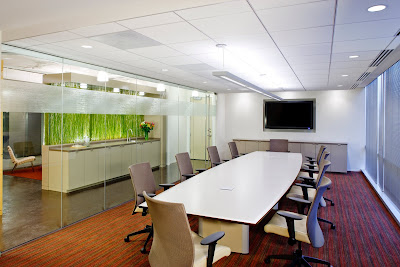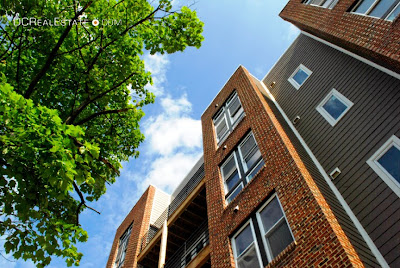
Pressure on
Mayor Adrian Fenty heated up today as questions increased about the Mayor's developer selection process amid news that
WMATA may be backing away from
Banneker Ventures as a development partner. Banneker has been awarded
numerous projects worth tens of millions of dollars by the Mayor's office despite its perceived lack of development experience.
Today, the WMATA board removed

the Banneker project "
The Jazz @ Florida Avenue" at
8th and Florida Avenue from the agenda for the real estate committee next Thursday, at which time it would have taken-up a joint development agreement for the WMATA-owned property. Today's move comes after WMATA issued a 120-day extension on the agreement in September 2009. Banneker was
chosen for the project in June of 2008, but has not yet started work on the site. More than a year later it
announced it would partner with Bank of America and had
petitioned for government funds, advances that were to have moved the project forward. The developer had already been pledged a $7m TIF grant from the District.
The move by WMATA likely comes in response to questions raised
first by this publication about justification for awarding so many projects to a team with so little apparent experience, then by the
CityPaper and
Washington Post about the how the relationship between Banneker's founder and D.C.
Mayor Adrian Fenty may have affected the selection process. The two men attended Howard University and were in the same fraternity.
In addition to the WMATA site on Florida Avenue, the virtually unknown Banneker has been selected by the District on numerous multi-million dollar projects throughout the city, despite a large roster of construction and development firms available for such projects as private financing for construction was drying up. Banneker's luck began in late 2007 when it was
selected by the District to be part of the $700 million
Northwest One project. Around the same time, Banneker was named as a master planner on the monstrous
Park Morton project (see
DC's summary). Despite lack of movement in those two projects, or on its private projects (see more below) it was then selected for a string of projects such as
the WMATA site in June of 2008, and by DC for the iconic
Strand Theater in July of that year, then in October to head the $33m
Deanwood Community Center project. In October of last year the District named
Landex Corp, Spectrum Management and the
Warrenton Group as developers of Park Morton. The Warrenton Group is run by a
former Banneker member that has also had a contentious relationship with the city.
Park Morton raised eyebrows at the Mayor's development process for yet another reason; the District announced just last October that the Mayor had selected its team members for Park Morton in part because that
development team said it controlled and would bring the Central Union Mission site into the development plan, increasing its scope.
DCMud learned a few days later that the
Missions' owners had never agreed to transfer their property to the development team, calling into question the District's selection process and the claims made by the development team to secure the project. Banneker is also being considered for its development offer at
Hill East, a massive 50-acre parcel on the Anacostia River. Banneker's publicly-funded projects at the WMATA site, the Strand, Park Morton have yet to break ground.
In a contentious
radio interview on the Kojo Nnamdi show following the announcement,
Omar Karim, founder and principal at Banneker Ventures, called out the WMATA board for further delaying review of the agreement on the
RFP awarded in 2008. In the interview, Karim, who dismissed suggestions that the board had legitimate concerns, argued that WMATA continued to "move the bar" on his project for "political" reasons. The Jazz @ Florida Avenue would theoretically bring 124 apartment units above 20,000 s.f. of ground floor retail and a 61-space parking garage to 3 flea market-sporting lots.
Tom Sherwood, resident analyst at NPR, asked Karim how many contracts he had received prior to Fenty taking office, to which Sherwood ultimately answered his own question with "none." Asked specifically about his experience, Karim answered that he had solid development experience at a large firm prior to starting Banneker, but would not name the firm or elaborate on the experience. As for Banneker's experience, Karim could only cite that his firm held an office building in Silver Spring and an unspecified site in which he "has been in conversations with Safeway about developing." At the time of publication, Safeway was unable to confirm or deny these conversations.
So what about that Silver Spring office building? That would presumably be 814 Thayer Avenue. Banneker purchased the site in May of 2006,
submitted plans later in the year, and in July 2007 obtained Montgomery County Planning Board approval of a preliminary plan for a 52-unit residential building, a plan that was
reviewed in November of 2007. The next step would be site plan approval, but, to date, the team has not even submitted a site plan to the planning staff for certification. Banneker will need a certified plan before the group can file for any construction permits for the property, making the September 2010 ground breaking date seem, at best, optimistic.

The 5-story Thayer project, designed by
Sorg & Associates, would entail construction of a 53-unit condominium, in place of National Association of the Deaf office building.
Joshua Sloan, a staff reviewer at the MNCPPC, provided an update on the project, "my understanding is that they want to amend their proposal, but I have not seen anything. I suppose it is "officially still pending." Sloan and his comments are the last stop before Banneker can proceed, a process which "can take a week or a year...depending on the Applicant’s response time to comments."
Banneker's website also boasts the
Pattern Shop Lofts on the Waterfront, a project led by Forest City Washington that has not yet broken ground. Banneker
registered with the District government as a small, minority-owned business in 2005.
Washington, DC real estate development news
 After all the speeches, ceremonial shoveling and $3.4 billion tab, St. Elizabeths, the largest federal construction project since the Pentagon, will not actually serve as the ultimate uniter of the disjointed Department of Homeland Security (DHS). A core 14,000 DHS personnel, just under half of its DC area employees, will relocate to 4.5 million s.f. of space in the massive federal project, also future home of the Coast Guard headquarters. And yet on April 1st, the General Services Administration (GSA) will issue a request for proposals (RFP) for DHS - 1.1 million s.f. of leased space in the DC metro area to consolidate employees.
After all the speeches, ceremonial shoveling and $3.4 billion tab, St. Elizabeths, the largest federal construction project since the Pentagon, will not actually serve as the ultimate uniter of the disjointed Department of Homeland Security (DHS). A core 14,000 DHS personnel, just under half of its DC area employees, will relocate to 4.5 million s.f. of space in the massive federal project, also future home of the Coast Guard headquarters. And yet on April 1st, the General Services Administration (GSA) will issue a request for proposals (RFP) for DHS - 1.1 million s.f. of leased space in the DC metro area to consolidate employees. In her statement yesterday to the House Appropriations subcommittee on Homeland Security Elaine Duke, Undersecretary for Management at Homeland Security, said the DHS currently occupies over 7 million s.f. of office space in 46 locations throughout the DC area. Currently over 180 leases are set to expire between now and 2015. Bob Peck, Commissioner of GSA's Public Buildings Service, said the consolidation will maintain the four federally owned properties - St. Elizabeths, the Nebraska Avenue temporary HQ, the Secret Service Building and space in the Ronald Regan Building - as well as two standing long-term leases. The RFP will add another one to three locations for which new leases will be awarded in 2011 with employees moving in two to three years thereafter.
In her statement yesterday to the House Appropriations subcommittee on Homeland Security Elaine Duke, Undersecretary for Management at Homeland Security, said the DHS currently occupies over 7 million s.f. of office space in 46 locations throughout the DC area. Currently over 180 leases are set to expire between now and 2015. Bob Peck, Commissioner of GSA's Public Buildings Service, said the consolidation will maintain the four federally owned properties - St. Elizabeths, the Nebraska Avenue temporary HQ, the Secret Service Building and space in the Ronald Regan Building - as well as two standing long-term leases. The RFP will add another one to three locations for which new leases will be awarded in 2011 with employees moving in two to three years thereafter. Though it is hard to imagine that a Pentagon- esque project is already insufficient to meet the needs of the agency for which it is being built, over-sized, empty commercial space in the DC area will get a boost. Properties like southwest's Constitution Center with its 1.3 million s.f. of space, blast-proof windows and in-house water filtration system leap to mind. There might even be available space in NoMa. Mike McGill, spokesperson for GSA in the National Capital Region, said the RFP does not require all 1.1 million s.f. of space to come from one location, smaller parcels may be eligible for consideration. GSA "is not against new construction, but we realize there is a lot of vacant existing space" in this climate. (We had heard the same rumor).
Though it is hard to imagine that a Pentagon- esque project is already insufficient to meet the needs of the agency for which it is being built, over-sized, empty commercial space in the DC area will get a boost. Properties like southwest's Constitution Center with its 1.3 million s.f. of space, blast-proof windows and in-house water filtration system leap to mind. There might even be available space in NoMa. Mike McGill, spokesperson for GSA in the National Capital Region, said the RFP does not require all 1.1 million s.f. of space to come from one location, smaller parcels may be eligible for consideration. GSA "is not against new construction, but we realize there is a lot of vacant existing space" in this climate. (We had heard the same rumor).

 Designed by architects
Designed by architects 
 Below-grade parking will add 340 residential spaces and 65 retail spaces, with garage entrances off 8th and 10th Streets.
Below-grade parking will add 340 residential spaces and 65 retail spaces, with garage entrances off 8th and 10th Streets.  Ronneberg said the ultimate goal behind the community amenities was to "help catalyze...the development of H Street" and that after hammering out the amenities over the past six months "there's certainly nothing major the ANC asked for that did not make it into the package."
Ronneberg said the ultimate goal behind the community amenities was to "help catalyze...the development of H Street" and that after hammering out the amenities over the past six months "there's certainly nothing major the ANC asked for that did not make it into the package." 


 spanning stem to stern. All the glass makes the interior feel larger than it appears from the outside.
spanning stem to stern. All the glass makes the interior feel larger than it appears from the outside. respecting the scale of the historic building. From the west, looking at the broad side, the Bikestation looks strangely at home against the backdrop of Burham’s ornate portico. Tilted and curved, it takes a moment to realize that the west wall of the Bikestation echoes the exposed roof trusses on the end walls of Burnham’s unpretentious concourse building to the north of the more ornate main building.
respecting the scale of the historic building. From the west, looking at the broad side, the Bikestation looks strangely at home against the backdrop of Burham’s ornate portico. Tilted and curved, it takes a moment to realize that the west wall of the Bikestation echoes the exposed roof trusses on the end walls of Burnham’s unpretentious concourse building to the north of the more ornate main building.






































